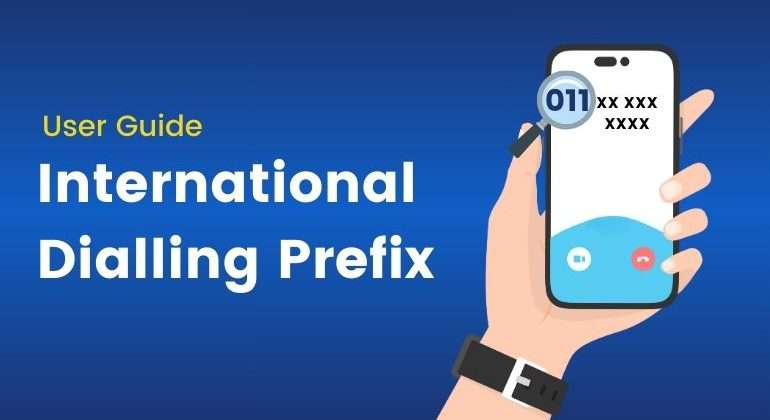In our increasingly connected world, making international calls is an everyday necessity. Whether you’re calling family overseas, conducting business with international partners, or exploring the world, understanding international calling prefixes is crucial. These codes today help us connect with our loved ones abroad and define the geographical region we are linking to.
An international dialing prefix is usually required when dialing from a landline phone. On the other hand, in a GSM-compliant cell phone, you can simply enter the country code after the ‘+’ sign, regardless of where the telephone is used. Moreover, the network operator automatically provides this number if you dial internationally from a mobile number.
This guide will help you navigate the different prefixes used around the globe. It also encompasses a list of international calling prefixes used worldwide. Without further ado, let’s begin.
Table of Contents
What Are International Calling Prefixes?
International calling prefixes are digits you dial before the country code and phone number when making a global call. These prefixes help route your call from your local network to the international destination. Different countries have different international calling prefixes. If you want to call abroad from a landline number, it is necessary to know the right international calling prefix to instantly connect with loved ones abroad.
Types of International Calling Prefix
Different types of calling prefixes includes:
The Common Prefix: 00
The International Telecommunication Union (ITU) recommends the prefix ’00’ as the most widely used international dialing prefix. Most countries in Africa, Asia, Europe, the Middle East, North America (excluding NANP countries), and South America use it.
Unique Prefixes by Country
While ’00’ is prevalent, some countries have unique prefixes:
000: Used by Kenya, Singapore, Tanzania, and Uganda.
001: Utilized by Guyana, Hong Kong (also 002 for fax/data), and Mongolia.
0011: Specific to Australia and its external territories.
009: Nigeria’s unique prefix.
00x: Brazil, Cambodia, Colombia, Indonesia, South Korea, Taiwan, and Thailand use various forms of 00 followed by an additional digit.
North American Numbering Plan (NANP)
Countries within the NANP use ‘011’ as their international dialing prefix. This includes the United States, Canada, and many Caribbean nations.
Carrier Selection Codes
Some countries offer carrier selection codes, allowing callers to choose their preferred carrier for international calls. This is common in:
Australia: Alongside ‘0011’, carriers like Primus (0014), Telstra (0018), and Optus (0019) offer options.
Hong Kong: With prefixes like 0030 (Hong Kong Broadband Network), 0050 (ComNet Telecom), and others.
Israel: Codes include 012 (Smile), 013 (NetVision), and more.
Singapore: Offers multiple options like 001 (SingTel), 002 (M1), and 008 (StarHub).
Comprehensive List of International Calling Prefixes
| Prefix | Countries Using Prefix |
|---|---|
| 00 | Samoa, Most of Africa, Most of Asia, Most of Europe, Most of the Middle East, Mexico, Greenland, St Pierre and Miquelon, Most of South America, Most of Oceania |
| 000 | Kenya, Singapore, Tanzania, Uganda |
| 001 | Guyana, Hong Kong (also 002 for fax/data), Mongolia |
| 0011 | Australia (including External Territories) |
| 009 | Nigeria |
| 00x | Brazil, Cambodia (001, 007), Colombia (005, 007, 009), Indonesia (001, 007, 008), South Korea, Taiwan, Thailand |
| 010 | Japan |
| 011 | All countries and territories in the North American Numbering Plan (NANP) |
| 1xx0 | Chile |
| 8~10 | Abkhazia, Belarus, Kazakhstan, Kyrgyzstan, Russia, South Ossetia, Tajikistan, Turkmenistan |
| Carrier Selection Codes | Countries that optionally allow for carrier selection |
| 00xx | Australia, Hong Kong, Israel, Kazakhstan, Singapore, Turkmenistan |
| 10xx | Georgia |
| 8~xx | Russia |
| 99x(yy) | Finland |
Historical Prefixes
Some prefixes are no longer in use but are part of the historical dialing landscape. These prefixes were once standard but have since been replaced as countries updated their telecommunication systems to align with international standards.
Japan: From ‘001’ to ‘010’
Japan previously used the prefix ‘001’ for international dialing. This was part of its older telecommunications system. However, to streamline and standardize the process, Japan switched to using ‘010’. This change made Japan’s system more consistent with international dialing norms, ensuring better connectivity and reducing the likelihood of dialing errors.
Former Soviet Union: From ‘8~10′ to ’00’
In the era of the Soviet Union, the prefix ‘8~10′ was used for international calls. This system was unique to the Soviet telecommunications network. Following the dissolution of the Soviet Union, many of the newly independent states transitioned to using ’00’ as their international calling prefix. This change helped integrate these countries into the global telecommunications infrastructure, making it easier for their residents to connect with the rest of the world.
The shift from ‘8~10′ to ’00’ has been adopted by many countries that were once part of the Soviet Union, including:
- Armenia
- Azerbaijan
- Estonia
- Georgia
- Latvia
- Lithuania
- Moldova
- Ukraine
- Uzbekistan
This transition marked a significant step in modernizing and globalizing the telecommunications systems of these countries.
Conclusion
Understanding international calling prefixes can simplify your global communication. Whether you’re making personal or business calls, knowing the correct prefix ensures your call reaches its destination without a hitch. Using the correct international calling prefix is not just a matter of convenience; it is essential for ensuring that your calls are successfully connected. Incorrect prefixes can lead to failed call attempts, misrouted calls, or even connecting to the wrong country. This can be particularly critical in business scenarios where timely and accurate communication is crucial.
